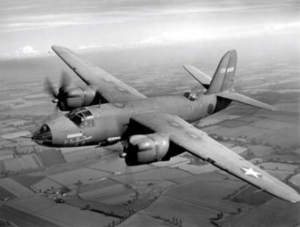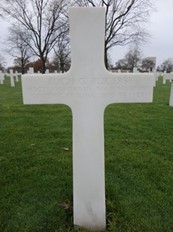Scroll of Honor – Pugh Rogers
Occupation Relocation
Written by: Kelly Durham
The war was over and it seemed as though much of the world was migrating. Civilians chased from their former homes by authoritarian regimes or flushed by the violence of combat were clogging European roads, searching for some place better to restart their lives. It wasn’t only civilians on the move. Military units from the victorious Allies were relocating to new duty stations from which to carry out peacetime missions that had more to do with rebuilding than retribution. The 495th Bomb Squadron was one of these organizations and one of its members was Pugh Geddings Rogers, Clemson Class of 1933.
The 495th was activated in late 1942 as a replacement training unit. A year later, it was reorganized as an operational squadron and deployed to Europe as part of the IX Bomber Command. From its bases in England, the medium bombers of the 495th attacked enemy tactical targets in occupied Europe. After D-Day, the 495th moved to the continent, establishing new bases in France and Belgium. The squadron often attacked enemy airfields to disrupt Luftwaffe fighter defenses against 8th Air Force heavy bomber formations flying to and from strategic targets in Germany.
 Pugh Rogers studied engineering at Clemson beginning in 1928. He left school after three years, but his engineering background helped prepare him for his wartime duties. Pugh was an Army Air Force master sergeant and crew chief. It was his job to supervise and lead a team of mechanics, armorers, technicians, and fuelers who often worked through the night to keep one of the squadron’s B-26 Martin bombers flying.
Pugh Rogers studied engineering at Clemson beginning in 1928. He left school after three years, but his engineering background helped prepare him for his wartime duties. Pugh was an Army Air Force master sergeant and crew chief. It was his job to supervise and lead a team of mechanics, armorers, technicians, and fuelers who often worked through the night to keep one of the squadron’s B-26 Martin bombers flying.
The end of combat operations meant a new role for the 495th and a new duty station. The 495th was designated to serve as part of the US occupation forces in Germany. In early September 1945, Rogers wrote that his squadron was packed and ready to move its base of operations from Florennes, Belgium to an airfield outside of Munich, Germany.
On September 10, Rogers climbed into a B-26 Martin medium bomber for the two hour flight to Schleissheim, on the northern outskirts of Munich. The aircraft, piloted by Captain Jerald Davies, was part of a multi-ship formation. In addition to three other crewmembers, the flight carried six passengers on their way to their new post.
Enroute from Florennes, Davies’s bomber became separated from the rest of the formation. Davies apparently lost his bearings and strayed to the southwest of Munich—and into the Bavarian Alps. All ten aboard the airplane were killed when it crashed into a mountain near Trauchgau, Germany, some fifty miles from its intended destination.
Master Sergeant Pugh Geddings Rogers was survived by his stepmother, two sisters, and one brother. In his last letter, Rogers wrote that he expected to return home a few weeks after the move to Munich.
Rogers was awarded the Bronze Star. He is buried in the Lorraine American Military Cemetery.
For more information on Pugh Geddings Rogers see:
https://soh.alumni.clemson.edu/scroll/pugh-geddings-rogers/
For additional information about Clemson University’s Scroll of Honor visit:
https://soh.alumni.clemson.edu/
